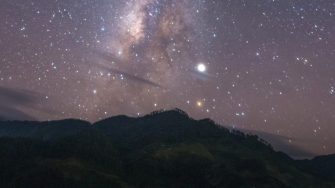
Exoplanets and Brown Dwarfs
Supervisor(s): Chris Tinney
Working with Veloce Rosso - Australia's Exoplanet Foundry
The $4.5m Veloce Rosso facility at the 3.9m Anglo-Australian Telescope has been operation now for about 2 years.
Veloce is a precision Doppler spectrograph that detects exoplanets by searching for the reflex Doppler wobble the induce in their host star, at velocities of less than 1m/s up to over 100 m/s. In its initial phase, it is observing at red wavelengths, targeting masses for low-mass, potentially habitable planets orbiting cool M-dwarf stars, as discovered by NASA's Transiting Exoplanet Survey Satellite mission. In 2022 it will be upgraded with another 2 arms, so that it can observe the entire optical wavelength range in one shot.
Our team is following up the transit candidates that have been emerging from NASA’s TESS satellite since 2018.
PhD and Honours students can be involved in undertaking observations with this instrument, developing calibration techniques, analysing data, and publishing results on new exoplanet detections and mass measurements.
We have a range of smaller projects suitable for Honours or undergraduate research projects - especially for students with an interest in computational techniques and programming/scripting.
NASA TESS Exoplanet Mission
Veloce strategically links with NASA's current exoplanet survey mission - TESS. NASA’s Kepler mission revolutionised our knowledge of the Galaxy’s stars and planets‡. But it has its problems, which include observing only faint stars clustered in a single northern field. Even more critically, its target stars were barely characterised when Kepler launched, and remain so to this day. Since what we know about Kepler’s planets relies on how well we understand its stars, this is a serious issue. The TESS satellite – with its all-sky survey of brighter stars that can be more readily followed up – is set to once more revolutionise our understanding of exoplanets (planets orbiting other stars). But for TESS to fully exploit its potential, its target stars must be fully characterised.
TESS launched on April 16, 2018, and (after carrying out a very cool series of manouvers to get it into a Moon-resonant, eccentric orbit) started an all-sy survey for new transiting systems.
Figure: Left. | The instantaneous combined field of view of the four TESS cameras. Middle. | Division of the celestial sphere into 26 observation sectors (13 per hemisphere). Right. | Duration of observations on the celestial sphere, taking into account the overlap between sectors. The dashed black circle encloses the ecliptic pole.
Veloce is specifically designed to allow follow-up of these TESS planets to deliver masses. The combination of Veloce masses and TESS planet sizes tells us the planet density, and this tells us whether these planets are rocky or icy!
